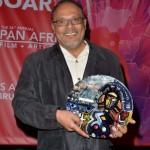Photos by Sam James, Community Photographer

Director Aminah Bakeer Abdul-Jabbaar accepts the “Audience Award – Narrative Feature” for “Muslimah’s Guide to Marriage”. Standing with her is her father, author/filmmaker, Donald Bakeer, and Ayuko Babu. (Photo Credit: Koi Sojer/Snap’N U Photos)
LOS ANGELES, CA – It’s a wrap! The 26th Annual Pan African Film & Arts Festival (PAFF) has reached its end, and after 12 full days of showcasing an impressive slate of 173 films, PAFF has finally announced the winners of its 2018 season.
At the highly anticipated PAFF Filmmaker Awards Brunch, which was held yesterday on festival grounds at the Baldwin Hills Crenshaw Plaza, PAFF Executive Director, Ayuko Babu, presented various awards to competing filmmakers who have proven to be the greatest up-and-coming storytellers of our time. The experience was an exciting celebration of both accomplishment and next level success.
CLICK HERE TO VIEW THE FULL LIST: PAFF 2018 Award Winners
Best Narrative Feature
Borders (Frontières) (Burkina Faso)
Directed by: Woye Apolline Traoré
Best Director-First Feature Narrative
Kalushi (South Africa)
Directed by: Mandlakayise Dube
Best Documentary Feature
Sammy Davis, Jr.: I’ve Gotta Be Me (US)
Directed by: Samuel D. Pollard
Best Narrative Short
Kyenvu (Yellow) (Uganda)
Directed by: Kemiyondo Coutinho
Best Documentary Short
Mama (US)
Directed by: Nicholas Brennan
Programmers’ Award-Narrative or Documentary Short
Lalo’s House (Haiti/US)
Directed by: Kelley Kali
Programmers’ Award-Documentary
Barrow-Freedom Fighter (Barbados)
Directed by: Marcia Weekes
Programmers’ Award-Narrative Feature
Love Jacked (South Africa)
Directed by: Alfons Adetuyi
PAFF Directors’ Award-Feature Documentary (TIE)
King of Stage: The Woodie King Jr. Story (US)
Directed by: Juney Smith
Maynard (US)
Directed by: Samuel D. Pollard
PAFF Directors’ Award- Feature Narrative
The Train of Salt and Sugar (Mozambique/South Africa)
Directed by: Licínio Azevedo
Audience Award- Documentary Short
’63 Boycott (US)
Directed by: Gordon Quinn
Audience Award- Documentary Feature
Sammy Davis, Jr.: I’ve Gotta Be Me (US)
Directed by: Samuel D. Pollard
Audience Award- Narrative Short
For Evan’s Sake (US)
Directed by: Kirstin Lorin
Audience Award- Narrative Feature
Muslimah’s Guide to Marriage (US)
Directed by: Aminah Bakeer Abdul-Jabbaar
PAFF FESTIVAL DATES CONFIRMED FOR 2019
The 27th Annual Pan African Film & Arts Festival will take place Thursday, February 7 through Monday, February 18 in Los Angeles, California. Stay tuned to the festival’s official website, www.PAFF.org, and social media channels for exciting updates, festival news and information!





By John Coleman, Community Photographer
SAN BERNARDINO, CA- It began early on Saturday, February 17, a situation in which many might expect college students to be anywhere other than back on campus and committed to an intense, high expectation workday that focused on improving their knowledge, skills and effectiveness at CITIZENSHIP!
On a beautiful sunny Sunday morning, Beautillion Knights spent time worshipping on February 18, at one of the former Sir Knight’s church, Dr. Regional Woods, Senior Pastor of Life Changing Ministries (LCM) and President of the Inland Empire Concerned African American Churches (IECAAC).
Social Lites, Inc. has been in the Inland Empire for 61 years and have been sponsoring the Beautillion Program for 51 years. Weekly meetings for Beautillion participants are held on Sundays from 2 p.m. to 4 p.m. at the Boys and Girls Club of San Bernardino. The 51st Beautillion program will commence on Saturday, March 24 at the National Orange Show.
For more information, please telephone Mrs. Donna Little-James, Chairperson at (909) 528-9793 or Mrs. Bridgette Shaw at (909) 648-6165 or Mrs. Twillea Evans-Carthen, Publicity Chairperson at tevanscarthen@yahoo.com.
By Naomi K. Bonman
As an Editor or any training professional for that matter, you feel like a proud parent when you see one of your former interns out there doing amazing things within their chosen career path. Noelle Lilley, a senior and Journalism major at Arizona State University, interned for the Westside Story Newspaper in the summer of 2014 during her senior year of high school.
So, what is Miss Noelle up to now? She is an investigative reporter for Cronkite News in Arizona. She also completed an internship in the summer of 2017 with 12 News. In addition to paving the path for her journalism career, Lilley is also a part of the National Association Black Journalist (NABJ) ASU Chapter. She was afforded the opportunity in attending the NABJ Convention and Career Fair last year in New Orleans.
Noelle is on the move and is not playing any games when it comes to propelling her career for after college. We are so proud of this one, but I knew she was destined for greatness from the beginning because her work ethic as an intern was exceptional.
To view the video interviews from the beginning of Noelle’s career to now, watch below:
INGLEWOOD, CA. – Majestic Hearts, a non-profit for victims of domestic violence and sexual assault, will celebrate its launch by hosting a fundraising event February 24 with the intent to raise funds for its shelter and counseling programs; its mission is to covert victims into survivors. The event will take place at Cal State University, Dominguez Hills from 5:30 p.m. to 7:30 p.m. (purple carpet and registration opening at 5 p.m.). With 2018’s goal to raise $50K, the event will kick-off the ultimate objective with the enthusiasm of generating $5K.
The launch event will include live performances by saxophonist Keschia Potter, who’s toured with celebrities like Beyoncé, Lady Gaga, Robin Thicke and Jennifer Hudson and a spoken word performance by artist Estee Marie (E dot Marie). Attendees will learn more about Majestic Hearts and why the organization was started.
“Domestic Violence is not only a National issue, but also an International one. Our duty at Majestic Hearts is to bring awareness to the masses by educating communities. With only a hand-full of DV shelters in Los Angeles County, we strive to offset this shortage by opening multiple shelters throughout the county over the next 10 years,” said Kanishia L. Jackson, Majestic Hearts CEO.
According to the National Coalition Against Domestic Violence, 1 in 4 women and 1 in 7 men have been severely physically abused by an intimate partner (www.ncadv.org) and 5 million children witnessing domestic violence each year in the U.S. (www.cdv.org). Our purpose is to target these demographics and convert these victims into survivors. We accomplish this through education and supportive services.
To learn more about Majestic Hearts and to register for this event, visit www.majestic-hearts.org.
LOS ANGELES, CA- On Saturday, February 17, The Black Barbershop Health Outreach Program will address the growing concern of African American men and health disparities during the Los Angeles Initiative of the ground-breaking grass-roots initiative. The Black Barbershop Health Outreach Program will offer from diabetes and hypertension screenings in Black-owned barbershops in Los Angeles and surrounding areas.
Founded in 2006, The Black Barbershop Health Outreach Program is the first initiative of its kind to exclusively address health care disparities among African American men on a national level. The Black Barbershop Health Outreach Program has screened over 30,000 African American men across the country for cardiovascular disease as well as prostate cancer. Now, the program is on a mission to screen and educate 1 million African American men for cardiovascular disease by the year 2020. The BBHOP will underscore the need for African American men to adopt healthier lifestyles and to promote early detection of diabetes and hypertension. Forty percent (40%) of African American men die prematurely from cardiovascular disease as compared to 21% of white men. Black men suffer far worse health conditions than any other racial group in America. There are a number of reasons for this. They include racial discrimination; a lack of affordable health services; poor health education, cultural barriers; poverty, employment that does not carry health insurance; insufficient medical and social services catering to black men.
The health fair will be held from 10 a.m. to 3 p.m. To find a local barbershop near you that is participating, please visit www.blackbarbershop.org.
By Margret Hill
Please allow me to introduce you to the San Bernardino Black Culture Foundation 2018 Senior King and Queen, Don and Celeste Griggs. Congratulations Royalty.
Mrs. Celeste Brown Griggs was born in Waterloo, Iowa. She graduated from East Waterloo High School in 1963, where she was a class mate and sweet heart of Don Griggs. Mrs. Griggs joined Don in California after his return from overseas duty. They were married in 1965 in Oceanside, California.
After moving to the Inland Empire, Celeste worked for Pacific Telephone Company and attended San Bernardino Valley College. She became a home maker with their three children for five years before deciding to return to the work force. She worked for Kaiser Permanent for twenty-seven years, retiring as Supervisor of staffing and payroll in the Appointment Center in Fontana.
Mr. Don Griggs was born in Waterloo, Iowa. He graduated from East Waterloo High School in 1961. Upon graduation, he enlisted in the United State Marine Corps where he served for four years. He was employed by Southern California Edison for ten years before entering the retail business. Eager to be involved with his new community, Don was instrumental in bringing Boy Scouting to the inner city of San Bernardino serving as a Neighborhood Commissioner over seeing several troops and Cub Packs during the late sixties. Don took boys on overnight scouting trips and chaperoned them at the Helen Dade Boy Scouts of America Camp in Lake Arrowhead during the summer.
Griggs is well known for his impeccable style of clothing and his love for neckties. He was co-owner of Irv Silvers Men’s Fashions for fifteen years, having stores located in the Inland Center Mall of San Bernardino and The Tyler Galleria of Riverside. He became President of the Merchants Association at Tyler Galleria.
He was hired by Nordstrom’s to manage the Men’s Clothing Department for fifteen years until he retired. While there, he was able to display and sell his personal design collection of ties; “Designs by Don”. Always one to ensure that employees of all races were treated with equity, Mr. Griggs co-founded the Diversity Board to oversee that a certain percentage of employees hired were people of color.
Mr. Griggs has been a small business owner for over thirty years. “I felt there was a niche market that had not been touched in men’s neckwear. I envisioned a quality line of African print men’s neckwear that would reflect elegance and significance, while appealing to professional and distinguished men.”
The Griggs were volunteers at Priscilla’s Helping Hands and now host H.U.G.S (Home Unity Growth Groups).
By Alysha Darby
I met a woman named “Debbie” at the Walmart in Redlands. She was the woman who checks the receipt as you’re walking out the door. I was struggling to get my receipt out of my wallet because I had a big box in my hand. Anyways, she was saying sorry that she had to do this it was a part of her job, I said, “Oh no worries.”
She said, “Yeah, I have stage III cancer but I still got to get up and come do my job because I need it, and I’m going to beat cancer. I’m a survivor.” Then she told me she wanted to get extensions like me and braids when her hair grows back! Then she told me she loved me and said, “Come see me again sister.”
After I spoke with one of Debbie’s daughters, she revealed to me that Debbie had been a district manager at Walmart for 23 years and that after being out of work for only four months (for radiation and Chemotherapy treatment) Walmart moved her down to a door greeter and cut her pay by $4 an hour! Debbie now has to work every single day while in pain, then goes home to take care of her own sick mother. Talk about a soldier! Debbie’s daughter explained to me that finances are a problem due to all Debbie’s expensive hospital bills.
Last week, me and my boyfriend Mo Ziah met up with Adrienne Braxton and Sonia Adams from Celebrating a Vision Foundation. We put together a gift basket for Ms. Debbie which included chocolate covered strawberries, a prayer blanket, gift cards, candles, a survivor t-shirt and a lot of chocolate covered goodies.
God is really working through me because I have never had so much passion to help someone that I didn’t even know! This is only the beginning.
I believe raising this money could honestly change Debbie’s life and at least allow her to battle this cancer head up without having financial problems as well. She deserves that chance! Please anything can help, thank you all. You can visit https://www.gofundme.com/debbie-lagaret-cancer-fighter to donate.
Construction-General Assembler-Door Assembly needed – in San Bernardino, CA. $11.50-$12.50/hr. Call (951) 823-0023
Bus Servicer needed – in Perris, CA. Call Mike (909) 636-6462
Material Handler-General Labor-Production needed – in Moreno Valley, CA. Call (951) 823-0023
Shop Labor needed – in Murrieta, CA. Apply in person 41205 Golden Gate Circle, Murrieta, CA 92562
General Service Tech/Tire Installer needed – in Woodcrest, Riverside, CA. Call Martha (951) 425-4100
Detailer needed – in Ontario, CA. Call Rod Gallagher (714) 809-0653
Freight Handler-3rd shift needed – in Fontana, CA. Call (877) 246-2855
Inventory Lead Associate needed – in Redlands, CA. Call (909) 328-4022
Necesitamos Personal Para Trabajar – in Ontario, CA. Call Miguel (951) 202-8131
Experienced EPJ Operators needed – in Riverside, CA. Call Mayra or Rhonda (909) 346-2008
Analytical Industries, Inc. – is seeking an Assembly Line Production Worker in Pomona, CA. $12.00-$12.50/hr. indeed.com
Humano, LLC – is seeking a Warehouse Freight Handler/Palletizer in Fontana, CA. $11.50-$16.50/hr. indeed.com
P. Richards – is seeking a Warehouse Associate/Order Filler (F/T) in Mira Loma, CA. $12.95/hr. www.indeed.com
Industrial Metal Supply – is seeking a 1st shift Material Handler-Puller Cutter in Riverside, CA. $14.00/hr. indeed.com
Living Spaces – is seeking an Order Picker in Rialto, CA. indeed.com
Pauley Construction, LLC – is seeking a Material Handler in Fontana, CA. indeed.com
Ryder – is seeking a Material Handler I in Ontario, CA. indeed.com
Western Metal Service – is seeking a Production Worker/Helper in Bloomington, CA. indeed.com
DHL Supply Chain – is seeking a Pallet Jack Operators in Ontario, CA. $14.35/hr. indeed.com
Manpower – is seeking an Inspector/Packer in Ontario, CA. $13.00/hr. indeed.com
A & R Tarpaulins – is seeking a Production Laborer-Entry Level in Fontana, CA. $11.00-$11.95/hr. indeed.com
P & E Construction, Inc. – is seeking a Driver/Stocker in Orange, CA. indeed.com
ABC Supply Co., Inc. – is seeking a Delivery Material Handler/Roof Loader in Riverside, CA. indeed.com
JHD Corporation – is seeking a Purchasing Assistant in Ontario, CA. $13.00-$18.00/hr. indeed.com
Eye Ojo Corporation – is seeking a Packaging Graphic Designer in Ontario, CA. $15.00/hr. indeed.com
Goodwill Industries of Southern California – is seeking a Material Handler I in Ontario, CA. indeed.com
GEODIS – is seeking a Material Handler in Rialto, CA. indeed.com
RTE Welding & Quality Tank Repair – is seeking a Parts Delivery Driver/Receiving Clerk in Fontana, CA. indeed.com
Select Staffing – is seeking a Material Handler in Mira Loma, CA. $13.10/hr. indeed.com
Manpower – is seeking a Product Handler in Irvine, CA. $13.00-$14.00/hr. indeed.com
TW Services – is seeking an Order Selector in Fontana, CA. $14.00/hr. indeed.com
Finish Master – is seeking a Distribution Center Order Selector in Mira Loma, CA. indeed.com
Novolex – is seeking a Packer Inspector in Rancho Cucamonga, CA. indeed.com
TST, Inc. – is seeking a Shipping/Receiving Worker in Fontana, CA. indeed.com
Greenpath Recovery, Inc. – is seeking a Logistics Coordinator in Colton, CA. indeed.com
Heydude Shoes-Wewood Watches – is seeking a Planner in San Bernardino, CA. $17.00/hr. indeed.com
Le Saint Logistics – is seeking an Inventory Control Clerk in Fontana, CA. indeed.com
Redneck Trailer Supplies – is seeking a Material Handler/Warehouse in Jurupa, CA. indeed.com
Loyalty Business Center – is seeking a General Laborer in Riverside, CA. $12.00/hr. indeed.com
Select Staffing – is seeking a Material Handler for Distribution in Mira Loma, CA. $12.60/hr. indeed.com
Simpson Strong Tie – is seeking a Production Worker-Autos in Riverside, CA. indeed.com
Aquamar – is seeking a Warehouse Clerk (Bilingual) in Rancho Cucamonga, CA. $11.00-$14.00/hr. indeed.com
Drive De Vilbiss Healthcare – is seeking a Shipping Clerk in Rialto, CA. $11.50/hr. indeed.com
Great Hire, Inc. – is seeking an Order Picker in Fontana, CA. $11.50/hr. indeed.com
Murtech Consulting – is seeking a Material Handler in Ontario, CA. indeed.com
Bob’s Discount Furniture – is seeking a Shipping-Picker in San Bernardino, CA. indeed.com
Kindred Healthcare – is seeking a Food Service Aide-Handler (P/T) Days in Ontario, CA. indeed.com
Christie Digital – is seeking a Picker/Packer in Riverside, CA. indeed.com
Unis Logistics – is seeking a DC Manager in the Inland Empire, CA. indeed.com
Niagara Bottling Co. – is seeking a Receiving Associate in Rialto, CA. indeed.com
ArdentMills – is seeking a Packing and Shipping Worker in Colton, CA. indeed.com
Southland Employment Services, Inc. – is seeking a Material Handler in Commerce, CA. $13.00-$15.00/hr. indeed.com
Packer Sanitation Services, Inc. – is seeking a Laborer (Hourly) in Ontario, CA. indeed.com
SunNest Services, LLC – is seeking a Shipping Clerk in Redlands, CA. $12.00/hr. indeed.com
First Rate Staffing – is seeking a Material Handler in San Bernardino, CA. $12.00/hr. indeed.com
Aman Garage Doors – is seeking a Warehouse/Back-up Driver in Rancho Cucamonga, CA. $15.50-$17.50/hr. indeed.com
WorkForce Enterprises – is seeking a Pick and Pack Worker in Fontana, CA. $11.00-$11.50/hr. indeed.com
York Employment Services, Inc. – is seeking a Loader/Order Selector in Mira Loma, CA. $14.00/hr. indeed.com
Big & Tall of DC – is seeking a Shipping/Warehouse Associate in Yorba Linda, CA. $11.50-$12.50/hr. indeed.com
Fed Ex Express – is seeking a Material Handler in Ontario, CA. indeed.com
York Employment – is seeking an Order Selector in Mira Loma, CA. $12.00-$13.00/hr. indeed.com
VWR International, LLC – is seeking a Warehouse Associate in Claremont, CA. indeed.com
Associate Direct Services, LLC – is seeking 3rd shift Packers/Empacadoreos in Industry, CA. $11.50-$11.75/hr. indeed.com
Villarreal Construction – is seeking a General Laborer in Riverside, CA. $100.00-$150.00/day. indeed.com
Staff Right Solutions – is seeking a General Laborer in Riverside, CA. $11.00-$12.00/hr. indeed.com
Hulcher Services, Inc. – is seeking a Skilled Laborer in Colton, CA. $18.77/hr. indeed.com
Army and Air Force Exchange Services – is seeking a Warehouse Worker in March AFB, CA. $13.19-$15.39/hr. indeed.com
Penske – is seeking a Recruiting Assistant in Corona, CA. indeed.com
Polyair – is seeking a Warehouse Associate in Corona, CA. indeed.com
DSV – is seeking a Customer Service Rep in Fontana, CA. indeed.com
Allied – is seeking a Receptionist/Administrative Assistant in Upland, CA. indeed.com
Judicial Council of California – is seeking a Deputy Clerk in Riverside, CA. indeed.com
San Bernardino County – is seeking a Senior Board Services Specialist in San Bernardino, CA. $17.75-$23.55/hr. indeed.com
YRC Freight – is seeking a Casual Clerk in Bloomington, CA. indeed.com
Learn 4 Life – is seeking a Registrar in Riverside, CA. indeed.com
East Valley Community Health Center – is seeking a Customer Service Rep-Reception in Pomona, CA. indeed.com
Reyes Coca-Cola Bottling – is seeking a Warehouse Inventory Control Assistant in Rancho Cucamonga, CA. indeed.com
Ponce Ground Services, LLC – is seeking a Front Desk Receptionist in Rancho Cucamonga, CA. $12.00/hr. indeed.com
Estes West–Division of Estes – is seeking a Terminal Clark III in Fontana, CA. indeed.com
JHD Corporation – is seeking a Purchasing Assistant in Ontario, CA. $13.00-$18.00/hr. indeed.com
Judicial Council of California – is seeking an Assistant Deputy Clerk I, II, III in Riverside, CA. indeed.com
XPo Logistics – is seeking a Customer Service Rep (F/T) in Fontana, CA. $17.93/hr. indeed.com
Career Strategies – is seeking a Leasing Consultant in the Inland Empire, CA. $11.00-$15.00/hr. indeed.com
No Contract VoIP – is seeking a Telecommunications Office Assistant in Upland, CA. indeed.com
Goodwill Industries – is seeking a Job Coach (P/T) in San Bernardino, CA. indeed.com
United Way – is seeking a Veterans Specialist in Rancho Cucamonga, CA. indeed.com
San Antonio Regional Hospital – is seeking a Patient Access Rep in Upland, CA. indeed.com
Monoprice – is seeking a Recruiter in Rancho Cucamonga, CA. $60,000.00-$75,000.00k/yr. indeed.com
CSPC Healthcare, Inc. – is seeking a Customer Service Rep/Assistant in Rancho Cucamonga, CA. indeed.com
Arrowhead Orthopaedics – is seeking a Therapy Front Desk Rep in Rancho Cucamonga, CA. indeed.com
Sedgwick Claims Management Services – is seeking a Claims Assistant-Entry Level in Riverside, CA. indeed.com
Joseph Cory Holdings, LLC – is seeking an Assistant Delivery Coordinator in San Bernardino, CA. indeed.com
Babcock Labs, Inc. – is seeking an Administrative Assistant in Riverside, CA. $12.00-$14.00/hr. indeed.com
M Squared Safety, LLC – is seeking an Administrative Support Assistant in Mission Viejo, CA. $12.00-$15.00/hr. indeed.com
Providence Speech and Hearing Center – is seeking a Patient Care Coordinator-Audiology in Mission Viejo, CA. $15.00-$16.00/hr. indeed.com
Bio Protech USA – is seeking an Administrative Sales Assistant in Chino, CA. $14.00-$15.00/hr. indeed.com
Clear Cloud Solutions, Inc. – is seeking an Administrative Assistant in Pomona, CA. $15.00-$25.00/hr. indeed.com
Associated Student, Inc. – is seeking a Human Resources Project Assistant in Pomona, CA. $30,703.00-$37,500.00k/yr. indeed.com
DALIX – is seeking an Administrative Support I in Rancho Cucamonga, CA. $11.00-$13.00/hr. indeed.com
Rusnak Auto Group – is seeking a Cashier in Loma Linda, CA. indeed.com
Integrated Care Communities – is seeking an Executive Secretary/Personal Assistant in Moreno Valley, CA. $14.00-$17.00/hr. indeed.com
ICI Services Corporation – is seeking a Warehouse Specialist in Corona, CA. indeed.com
LA Fitness – is seeking a Front Desk Staff in San Bernardino, CA. indeed.com
Pacific Hospice – is seeking a Volunteer with Hospice in San Bernardino, CA. indeed.com
Penske – is seeking a Recruiting Assistant in Corona, CA. indeed.com
PLS – is seeking a Graphic Designer in Ontario, CA. indeed.com
Pacific Dermatology Institute – is seeking a Bilingual Front Office Medical Receptionist in the Inland Empire, CA. indeed.com
Covina Valley Management, Inc. – Citrus Diagnostics – is seeking a Medical Receptionist in Glendora, CA. $14.60/hr. indeed.com
Ajilon – is seeking an Export Clerk in Rancho Cucamonga, CA. $14.00-$16.00/hr. indeed.com
Loma Linda University Medical Center – is seeking a Unit Secretary in Loma Linda, CA. indeed.com
Pinnacle Hotels USA – is seeking a Concierge in Riverside, CA. indeed.com
Rusnak Auto Group – is seeking a Warranty Clerk/Office Assistant in Loma Linda, CA. indeed.com
San Manuel Casino – is seeking a PBX Operator in Highland, CA. indeed.com
American Solar Advantage – is seeking a Project Coordinator/Administrative Assistant in Chino, CA. $12.00/hr. indeed.com
US Bank – is seeking an Administrative Assistant in Rancho Cucamonga, CA. indeed.com
San Bernardino County – is seeking a Health Information Coding Supervisor in Colton, CA. $25.76-$35.41/hr. indeed.com
Staffing Network QPA – is seeking an Accounts Receivable Clerk in Ontario, CA. $15.00-$16.00/hr. indeed.com
Road Dog Crew – is seeking a Warehouse Clerk in Corona, CA. $14.00/hr. indeed.com
Konnect Resources – is seeking a Data Entry Clerk (Temp) in Corona, CA. $12.00-$14.00/hr. indeed.com
LANI – is seeking a Medical Records Coder in Riverside, CA. $17.99-$29.63/hr. indeed.com
San Antonio Regional Hospital – is seeking a Pharmacy Tech in Upland, CA. indeed.com
YRC Freight – is seeking a Supervisor-Freight (P/T) in Bloomington, CA. indeed.com
Hampton Inn & Suites by Hilton – is seeking a Night Auditor/Front Desk Agent in Chino Hills, CA. indeed.com
ABI Document Support Services – is seeking an Order Entry Specialist I in Loma Linda, CA. indeed.com
Pitney Bowes – is seeking an Operations Administrative Assistant 2nd shift in Corona, CA. indeed.com
TELECU Residential Management – is seeking a Resident Service Coordinator in San Bernardino, CA. $47,476.00k/yr. indeed.com
The Villalobos Group – is seeking an Office Assistant in Riverside, CA. $15.00/hr. indeed.com
Symons Ambulance – is seeking a Medical Records Clerk in San Bernardino, CA. $10.00/hr. indeed.com
CorVel Corporation – is seeking a Lien Unit Administrative Assistant in Rancho Cucamonga, CA. indeed.com
Loma Linda University Shared Services – is seeking an Office Clerk in Loma Linda, CA. indeed.com
Eco Fresh HVAC, Inc. – is seeking a Receptionist (F/T) in Anaheim, CA. indeed.com
 Westside Story Newspaper – Online The News of The Empire – Sharing the Quest for Excellence
Westside Story Newspaper – Online The News of The Empire – Sharing the Quest for Excellence